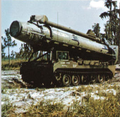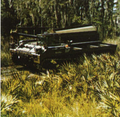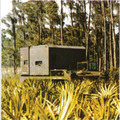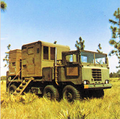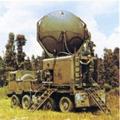Pershing 1
| Pershing 1 [a] | |
|---|---|
 Pershing round 32 launched from Hueco Range, Texas by A Battery, 2nd Battalion, 44th Field Artillery, targeted for White Sands Missile Range on 20 August 1963 | |
| Type | Short-range ballistic missile |
| Place of origin | United States |
| Service history | |
| In service | 1962–1969 |
| Used by |
|
| Production history | |
| Designer | The Martin Company |
| Designed | 1958–1960 |
| Manufacturer | The Martin Company Martin Marietta |
| Produced | 1960–1969 |
| No. built | 754 MGM-31A missiles |
| Specifications | |
| Mass | 10,275 pounds (4,661 kg) [1] |
| Length | 34.6 feet (10.5 m) |
| Diameter | 40 inches (1 m) |
| Blast yield |
|
| Engine |
|
Operational range | 460 miles (740 km) |
| Boost time | 77.3 seconds |
| Maximum speed | Mach 8 |
Guidance system | Eclipse-Pioneer ST-120 inertial guidance |
Steering system | Jet vanes, air vanes |
| Accuracy | 1,310 feet (400 m) circular error probable |
Launch platform | M474 transporter erector launcher |
Development
George Bunker, president of the Martin Company, paid a courtesy call on General John Medaris, USA, of the Army Ballistic Missile Agency (ABMA) at Redstone Arsenal, Alabama in 1956. [2] Medaris noted that it would be helpful to the Army if there was a missile plant near the Air Force Missile Test Center (present-day Cape Canaveral Air Force Station) in Florida. The Martin Company subsequently began construction of their Sand Lake facility in Orlando, Florida which opened in late 1957. Edward Uhl, the co-inventor of the bazooka, was the vice-president and general manager of the new factory, which continues to operate today as the Lockheed Martin Missiles and Fire Control facility.
The U.S. Army began studies in 1956 for a ballistic missile with a range of about 500–750 nautical miles (930–1,390 km; 580–860 mi). Later that year, Secretary of Defense Charles Erwin Wilson issued the "Wilson Memorandum" that removed from the U.S. Army all missiles with a range of 200 miles (320 km) or more. [3] The United States Department of Defense (DoD) rescinded the memorandum in 1958 and ABMA began development of the class of ballistic missile.
The missile was initially called the Redstone-S, where the S meant solid propellant (and the name Redstone came from the Redstone missile it was supposed to replace), but renamed to Pershing in honor of General of the Armies John J. Pershing. ABMA selected seven companies to develop engineering proposals: Chrysler, the Lockheed Corporation, the Douglas Aircraft Company, the Convair Division of General Dynamics, the Firestone Corp., the Sperry-Rand Company, and the Martin Company. [2]
The Secretary of the Army, Wilber M. Brucker, the former governor of Michigan – was apparently under pressure from his home state to award the contract to a company in Michigan. [2] Chrysler was the only contractor from Michigan, but Medaris persuaded Brucker to leave the decision entirely in the hands of the ABMA. After a selection process by General Medaris and Dr. Arthur Rudolph, the Martin Company (later Martin Marietta after a merger in 1961) was awarded a CPFF (cost-plus-fixed-fee) contract for research, development, and first production of the Pershing system under the technical supervision and concept control of the government. Martin's quality control manager for the Pershing, Phil Crosby developed the concept of Zero Defects that enhanced the production and reliability of the system.
The first launch of the XM14 R&D Pershing 1 test missile (P-01) was on 25 February 1960. The first launch from the tactical transporter erector launcher (TEL) was on 26 July 1960 (P-06). [4] For training there was an inert Pershing 1 missile designated XM19. In June 1963, the XM14 and XM19 Pershing missiles were redesignated as XMGM-31A and XMTM-31B, respectively. The production version of the tactical missile was later designated as MGM-31A and the XMTM-31B designation was dropped.
Deployment
President Eisenhower viewed the Pershing missile when he visited Cape Canaveral on 11 February 1960, [5] and at Fort Benning on 5 May 1960 as part of Project MAN (Modern Army Needs). [6] [7] President Kennedy viewed Pershing three times: as part of the inaugural parade in 1961, [8] [9] at Fort Bragg on 12 October 1961, [10] and at White Sands Missile Range in 1963. [11]
Plans were for the organization of ten missile battalions: one at Fort Sill, one in Korea and eight in West Germany; this was eventually reduced to one battalion at Fort Sill and three in West Germany. [12]
Each missile battalion organized at Fort Sill for deployment. The first tactical Pershing unit was the 2nd Missile Battalion, 44th Artillery Regiment, followed by the 4th Missile Battalion, 41st Artillery Regiment deployed to Schwäbisch Gmünd and the 1st Missile Battalion, 81st Artillery to McCully Barracks in Wackernheim. Each missile battalion had four launchers.
The 2nd Missile Battalion, 79th Artillery Regiment formed for deployment to South Korea in February 1964. The deployment was placed on hold and the battalion supported the 56th Artillery Group and the German Air Force missile wings when they launched missiles from White Sands Missile Range. The 85th U.S. Army Field Artillery Detachment was organized in Fort Sill in November 1966 and attached to 2/79th Artillery. The deployment to Korea was canceled and the 2/79th Artillery was deactivated.
The Secretary of Defense assigned the Pershing weapon system to a Quick Reaction Alert (QRA) role in 1964 after a DoD study showed that the Pershing would be superior to tactical aircraft for the QRA mission. The German Air Force began training at Fort Sill. Each missile battalion was then authorized six launchers. [13] In 1965 this increased to eight launchers, two per firing battery. By 1965, three U.S. Army battalions and two German Air Force wings were operational in Germany. The 579th Ordnance Company was tasked with maintenance and logistical general support for the Pershing artillery units in Germany.
Missile

Two Thiokol solid-propellant motors powered the Pershing 1 missile. Since a solid-propellant motor cannot be turned off, the missile used thrust reversal and case venting for a selective range. Splice bands and explosive bolts attached the rocket motors. The missile was controlled by an analog guidance computer using a ball-and-disk integrator and a control computer. As directed by the onboard computers, the bolts exploded and ejected the splice band. Another squib would open the thrust reversal ports in the forward end of the stage and ignite the propellant in the forward end, causing the motor to reverse direction. Testing found that the second stage would draft behind the warhead and cause it to drift off course, so explosive charges on the side of the motor opened the case and vented the propellant. The range could be graduated but the maximum was 740 kilometres (400 nmi). Jet vanes in the motor nozzles and air vanes on the motor case steered the missile. The onboard analog guidance computer and the Eclipse-Pioneer ST-120 (Stable Table-120) inertial navigation system provided guidance. The warhead could be conventional explosive or a W50 nuclear weapon with three yield options— the Y1 with 60 kiloton yield, Y2 with 200 kiloton yield and Y3 with 400 kiloton yield; the conventional warhead was never deployed.
Ground equipment

The Pershing 1 firing platoon consisted of four M474 tracked-vehicles manufactured by FMC Corporation— by comparison, Redstone needed twenty vehicles. The transporter erector launcher (TEL) transported the two stages and the guidance section as an assembly and provided the launch platform after the warhead was mated. It used a removable erector launcher manufactured by Unidynamics. The warhead carrier transported the warhead, the missile fins and the azimuth laying set used to position the missile. The PTS/PS carrier transported the programmer test station (PTS) and power station (PS). A fourth vehicle transported the Radio Terminal Set. The four vehicles were known as the land train.
The PTS featured rapid missile checkout and countdowns, with complete computer control, and automatic self-test and malfunction isolation. Additionally, the PTS would perform tests that simulated airborne missile operation, programmed the trajectory of the missile and controlled the firing sequence. Plug-in micromodules increased maintainability and allowed the PTS operator to perform 80% of all repairs at the firing position. A turbine driven Power Station mounted behind the PTS, provided the primary electrical and pneumatic power and conditioned air for the missile and ground support equipment at the firing position.
Collins Radio Company produced the AN/TRC-80 Radio Terminal Set specifically for the Pershing system. The "Track 80" used an inflatable dish antenna to provide line-of-sight or tropospheric-scatter voice and teleprinter communications between missile firing units and higher headquarters. The erector-launcher, PTS, PS and RTS could be removed from the carriers and air-transported in fourteen CH-47 Chinook loads. [14]
Orientation
The missile was positioned or laid in on a pre-surveyed site with a system of two theodolites and a target card. Directional control passed from one theodolite to the one next to the missile. The missile then oriented to north by an operator using a horizontal laying theodolite aimed at a window in the guidance section of the missile. Using a control box, the ST-120 inertial navigation system in the guidance section rotated into alignment and the north direction programmed into the computer.
Satellite launcher

In 1961, Martin proposed a satellite launch system based on the Pershing. Named Pegasus, it would have had a lighter, simplified guidance section and a short third stage booster. [15] A 60-pound (27 kg) payload could be boosted to a 210-mile (340 km) circular orbit, or to an elliptical orbit with a 700-mile (1,130 km) apogee. Pegasus would have used the Pershing erector-launcher and could be placed in any open area. Martin seems to have targeted the nascent European space program, but this system was never developed.
APL
In 1965, the Army contracted with the Applied Physics Laboratory (APL) of Johns Hopkins University to develop and implement a test and evaluation program. [16] APL provided technical support to the Pershing Operational Test Unit (POTU), identified problem areas and improved the performance and survivability of the Pershing systems. [17]
Gallery
- Pershing 1 land train
- Missile carrier
- Warhead carrier
- Programmer Test Station and Power station
- AN/TRC-80 Radio Terminal Set
